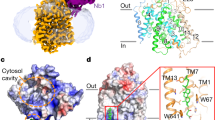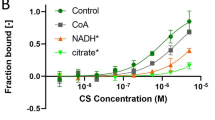Abstract
THE passage of glucose across the muscle cell membrane appears to be a major site for regulation of glucose uptake in this tissue. Accelerating effects on glucose uptake both of insulin and of factors such as anoxia which inhibit oxidative phosphorylation appear to result in skeletal and cardiac muscle from an enhanced rate of transfer of the sugar across the muscle cell membrane1–4. Recent studies5 have emphasized that the movement of sugars across the cell membrane is predominantly a transport process, that is, it involves combination of the sugar with a particular constituent of the cell. In the present investigation we have sought to define the specificity of monosaccharide transport systems in diaphragm by determining which monosaccharides compete for transport and to obtain information about the nature of the system by studying the effect of certain enzyme inhibitors on transport of monosaccharides.
This is a preview of subscription content, access via your institution
Access options
Subscribe to this journal
Receive 51 print issues and online access
$199.00 per year
only $3.90 per issue
Buy this article
- Purchase on Springer Link
- Instant access to full article PDF
Prices may be subject to local taxes which are calculated during checkout
Similar content being viewed by others
References
Levine, R., and Goldstein, M. S., Rec. Prog. Hormone Res., 11, 343 (1955).
Park, C. R., Bornstein, J., and Post, R. L., Amer. J. Physiol., 182, 12 (1955).
Randle, P. J., and Smith, G. H., Biochem. J., 70, 490, 501 (1958).
Morgan, H. E., Randle, P. J., and Regen, D. M., Biochem. J. (in the press).
Park, C. R., Reinwein, D., Henderson, M. J., Cadenas, E., and Morgan, H. E., Amer. J. Med., 26, 674 (1959).
Gey, G. O., and Gey, M. K., Amer. J. Cancer, 27, 45 (1936).
Somogyi, M., J. Biol. Chem., 160, 69 (1945).
Kipnis, D. M., and Cori, C. F., J. Biol. Chem., 234, 171 (1959).
Dixon, M., and Webb, E., ‘Enzymes’ (Longmans Green and Co., London, 1958).
Sols, A., and Crane, R. K., J. Biol. Chem., 210, 581 (1954).
Crane, R. K., and Sols, A., J. Biol. Chem., 203, 273 (1953).
Lardy, H. A., and Parks, R. E., jun., in ‘Enzymes, Units of Biological Structure and Function’, Ed. O. H. Gaebler, 584 (Academic Press, New York, 1956).
Rall, T. W., Sutherland, E. W., and Wosilait, W. D., J. Biol. Chem., 218, 483 (1956).
Krebs, E. G., and Fischer, E. H., Biochim. Biophys. Acta, 20, 150 (1956).
Author information
Authors and Affiliations
Rights and permissions
About this article
Cite this article
BATTAGLIA, F., RANDLE, P. Monosaccharide Transport in Rat Diaphragm Muscle. Nature 184, 1713–1714 (1959). https://doi.org/10.1038/1841713a0
Issue Date:
DOI: https://doi.org/10.1038/1841713a0
This article is cited by
-
Körpereigene Stoffe
Naunyn-Schmiedebergs Archiv für Experimentelle Pathologie und Pharmakologie (1961)
Comments
By submitting a comment you agree to abide by our Terms and Community Guidelines. If you find something abusive or that does not comply with our terms or guidelines please flag it as inappropriate.



